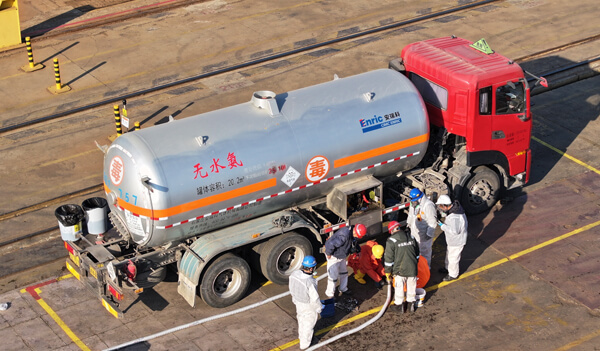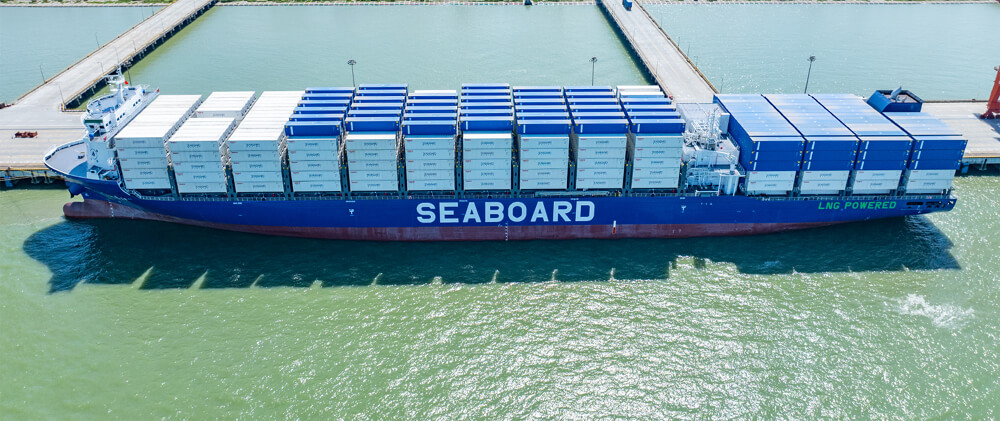ALT FUELS
China Conducts Its First Ammonia Bunkering Operation with Demonstration Tug

China completed its first domestic ammonia bunkering operation for a vessel and one of only a handful of ammonia bunkers conducted worldwide. It is part of a broader demonstration project launched in China in 2022 to develop an ammonia-fueled tugboat.
The bunkering operation took place on December 24 in Dalian at the COSCO Shipping Heavy Industries shipyard which has also completed the construction of the tug Yuan Tuo Yi. The fueling was carried out by vehicle in a truck-to-ship method. It lasted two hours but they did not indicate the quantity of ammonia fuel loaded.
According to the reports, the bunkering was undertaken by the Sinopec COSCO Shipping Marine Fuel Supply Company after extensive testing and planning. The company conducted research on the ammonia fueling process, a safety assurance plan, and an emergency response plan in preparation for the bunkering operation.

Bunkering operation was conducted truck-to-ship in Dalian (COSCO)
The tug Yuan Tuo Yi is the result of an extensive research program that included the design and development of the engine and the fuel supply system. The report indicates the project earned Approval in Principle from both the Chian Classification Society (CCS) and ABS for the design of the ammonia-powered tugboat and the ammonia fuel supply systems. CCS conducted product test certification.
Construction of the tug started in January 2024. It employs the CRRC Dachai 12V240HDFA ammonia-diesel dual-fuel engine and a fuel supply system developed by Weihai Heavy Industry Technology. The tug, which measures approximately 125 feet (38 meters) in length had two C-type liquid ammonia storage tanks.
Chinese officials reported in 2023 that they had successfully operated a medium-speed ammonia dual-fuel engine. They indicated an energy substitution rate of over 90 percent and a thermal efficiency of over 40 percent within the stable operating range. Previously, with a single-cylinder engine, they reported reaching 208kW, with ammonia energy accounting for 85 percent. Carbon emissions were reduced by 80 percent.
The world’s first ammonia bunkering for a vessel took place earlier this year in Singapore as part of a test program using an offshore vessel converted by Fortescue. During the summer, NYK fueled its tug with ammonia after a conversion from LNG. U.S.-based Amogy also demonstrated its ammonia-fueled tug using technology that incorporates cracking.
Construction has started on the first ammonia-ready and ammonia dual-fuel large commercial ships which the engine companies work to complete their efforts leading to the commercial introduction of ammonia engines. Infrastructure development is also underway to support the introduction of ammonia as a marine fuel in the coming years.
Seaboard Marine Integrates LNG-Fueled Containerships into Fleet

Miami-based carrier Seaboard Marine is beginning the integration of a new class of innovative LNG-fueled containerships into its fleet servicing South America. The U.S. carrier highlights the advanced features and increased capacity as it placed the first two vessels of its new V-Class into the fleet with a total of six ships of the class due by the end of 2025.
Seaboard is part of a trend among U.S. carriers that have embraced LNG for its environmental properties and efficiency. TOTE claims the honor of introducing in 2018 the first LNG-fueled containership and has continued to expand its fleet. Pasha has also added LNG-fueled vessels including the newbuilds George III and Janet Marie while Matson has also started LNG conversions for its LNG-ready vessels while also ordering new dual-fuel containerships.
HB Hunte of Germany designed the new class of vessels for Seaboard Marine and they were ordered from China’s Taizhou Sanfu Ship Engineering Company. The original order was expanded in 2023 when Seaboard exercised the options for three additional ships. The shipyard highlights they are the largest containerships built by the yard.

Seaboard Victory recently made her first port calls in Peru showing the unique design of the vessels (Seaboard Marine)
Among the unique elements of the design is the first adoption of the double C-type vertical gas tanks. The tanks on the Seaboard vessels are reported to be the world’s largest vertical gas tanks so far deployed on a ship. The vessels also adopt a new bow arrangement.
Taizhou reports the design emphasizes ecological sustainability. The dual-fuel engines, MAN B&W 7570ME-C10, operate on LNG or MGO (marine gas oil). Each ship has two diesel generators and one LNG generator. They have been classed by DNV and are reported to have a design speed of 19.5 knots.
“The Seaboard Victory marks an exciting milestone as the second ship in our cutting-edge V-Class series of six vessels and the second of eight new LNG-powered ships transforming our fleet,” said Eddie Gonzalez, President and CEO of Seaboard Marine announcing the introduction of the vessel. “Its arrival reflects our dedication to sustainability and delivering exceptional service to our customers.”
Seaboard Victory followed Seaboard Voyager which completed sea trials in August and was integrated into the fleet in November. Seaboard Victory entered service this month recently making her first calls in Callao and Pisco, Peru. The ships join a route between the U.S., the Caribbean, Central and South America.
Each of the vessels has a capacity for 3,500 TEU including over 1,000 reefer plugs. At approximately 52,500 dwt the ships are registered in Liberia.

Seaboard Blue is the company's first LNG vessel and became the first LNG cargo ship to bunker at PortMiami (Seaboard Marine)
Seaboard Marine adopted its first LNG-fueled vessel in 2023 with the purchase of the Elbblue (13,200 dwt) which had been built in 2011 and operated for Wessels Reederei as Wes Amelie. She was retrofitted in 2017 for LNG operations. The vessel has a capacity of 1,000 TEU. Operating as Seaboard Blue, she also became in March 2023 the first LNG-fueled containership to bunker at PortMiami, Florida before her inaugural sailing to Honduras and Guatemala.
The company reports it will have a total of eight LNG-powered vessels by the end of 2025. Overall, containerships are the largest segment of LNG-fueled vessels according to DNV’s Alternative Fuels Insight database. It shows a total of 127 LNG-fueled containerships currently in service with an additional 314 on order and deliveries to accelerate over the next four years. By 2028, DNV projects over 400 LNG-fueled containerships in service.
No comments:
Post a Comment